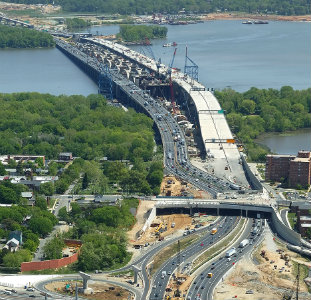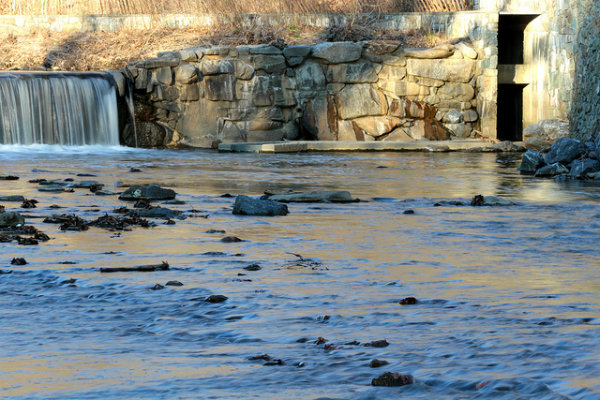
"New-School Bridge, Old-School Look" (CC BY-NC-ND 2.0) by Rich Renomeron
The National Environmental Policy Act (NEPA) requires the federal government to consider environmental impacts in its decision-making process. Thus, project planning teams must conduct environmental planning from the beginning. Project managers can then reduce delays and the potential for cost overruns by identifying issues early. Learn more about NEPA.

This project replaced the Woodrow Wilson Bridge, which crosses the Potomac River to connect Maryland and Virginia. A small portion of the bridge is in Washington, DC. The bridge is part of both I-95, which spans the East Coast, and the Capital Beltway (I-495), which circles Washington, DC. Thus, it accommodates a large volume of traffic.
The challenges discussed below relate to NEPA’s environmental planning process. We do not discuss issues outside this scope.
The bridge replacement was complex from the start, because this federal highway spans three separate jurisdictions. Thus, the bridge required many agencies to cooperate while the Federal Highway Administration (FHWA) took the lead. FHWA also had to testify before Congress to request funding. Consequently, the project received congressional oversight and scrutiny.
FHWA took three major steps to overcome its coordination challenge:
Source — Strategic Highway Research Program case study
 The project received a lot of public attention and concern compared to other projects of similar size. Its location and use of public funds generated curiosity. Thus, FHWA involved the public frequently and through many means, which included the following1:
The project received a lot of public attention and concern compared to other projects of similar size. Its location and use of public funds generated curiosity. Thus, FHWA involved the public frequently and through many means, which included the following1:
Outreach efforts covered environmental impacts and other topics. Public confidence in the project rose moving forward, because FHWA continued to make information available. A 1996 survey showed 51% confidence in the project, which rose to 91% by 20002. The main factor for the increase was confidence that the project would remain on schedule. A project’s schedule relies on environmental compliance, because permit issues cause delays.
Sources

The NEPA review identified adverse impacts to the environment that required mitigation to reduce the effects. Many permits require a project to have mitigation measures. The project planning team worked together to develop mitigation measures that went beyond minimum protections1. The list of mitigation measures covered several pages in the final environmental impact statement (EIS)1.
FHWA created an independent monitoring program to review impacts2. The move increased transparency and confidence in the project. The oversight group developed an associated database and made it available to regulatory agencies2. The project received the 2004 Globe Award from the American Road and Transportation Builders Association for overcoming environmental challenges3.
Sources
 Yes, a group sued this project even though it followed the above steps. NEPA’s broadness gives an easy way to oppose a project. The law requires each project to identify significant environmental impacts and publicly disclose them. The public can easily argue that an impact has not been identified and/or reviewed satisfactorily. Read more about why people sue under NEPA.
Yes, a group sued this project even though it followed the above steps. NEPA’s broadness gives an easy way to oppose a project. The law requires each project to identify significant environmental impacts and publicly disclose them. The public can easily argue that an impact has not been identified and/or reviewed satisfactorily. Read more about why people sue under NEPA.
FHWA lost the first court case, but won an appeal because of their thorough environmental review process. The table below shows the lawsuit’s allegations and the government’s responses. Note that NEPA analyses usually include historic and cultural resource impact reviews required under National Historic Preservation Act (NHPA) Section 106.
| Lawsuit Allegations | Government Response |
|---|---|
| FHWA violated NEPA because it failed to deem a ten-lane bridge a “reasonable alternative” for analysis alongside the twelve-lane preferred alternative. The ten-lane alternative would reduce traffic congestion with less environmental and cultural resource impacts. | The EIS excluded a ten-lane alternative after studies showed it did not meet traffic capacity needs. Thus, the alternative did not require further analysis. Further, a ten-lane bridge would impact only 1.6 fewer acres of parkland and 12.9 fewer acres of natural resources. It would have an identical impact on cultural resources. |
| The EIS does not adequately identify and discuss temporary construction-related impacts. | The EIS cannot discuss specific construction-related impacts because the project planning team identifies construction sites at a later stage. Thus, a general discussion is sufficient. |
| The EIS does not adequately address impacts to historic sites because it postponed identification of the affected sites. | FHWA identified and surveyed 59 historic and cultural sites in the project area. Also, the project planning team visited sites that the project could potentially visually impact. They could not accurately identify affected sites because the project planning team completes design work at a later stage. |